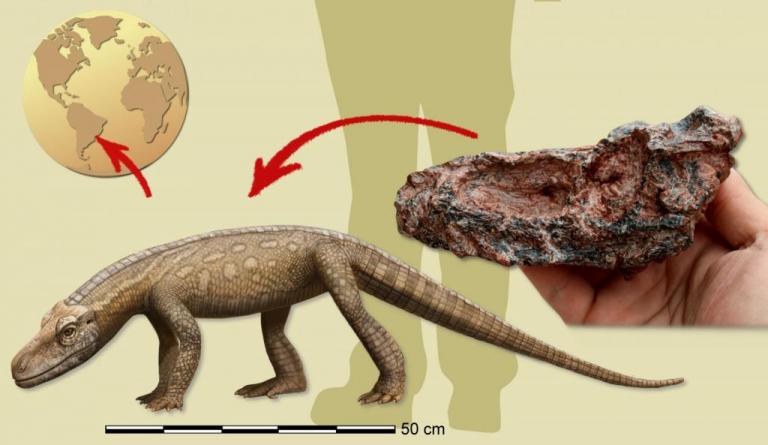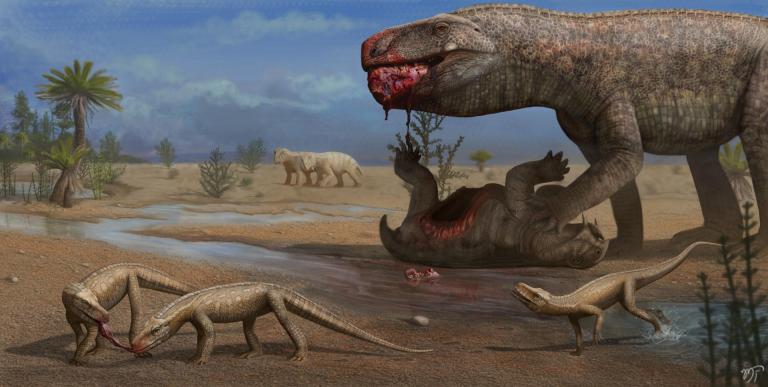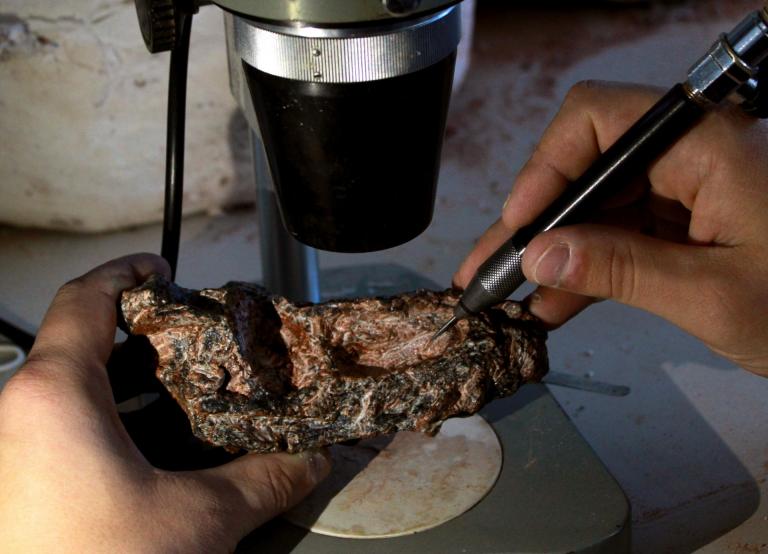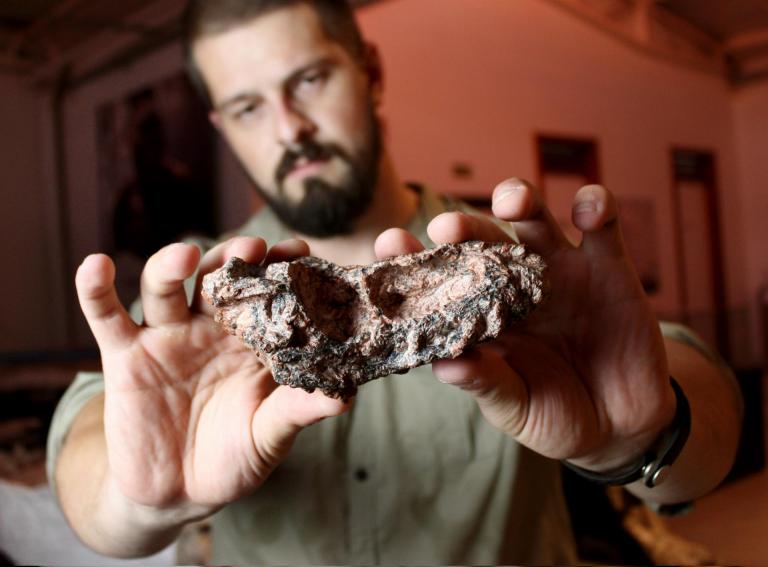Discovery by a paleontologist from CAPPA/UFSM was published in an international scientific journal
A paleontologist from UFSM published a study in the Scientific Reports journal on Thursday (20) describing a new species of fossil reptile from the municipality of Paraíso do Sul, in the central region of Rio Grande do Sul. The discovery reveals the first Brazilian record of a group called Gracilisuchidae, which was previously known only in Argentina and China.
Before the emergence of dinosaurs, ecosystems were dominated by precursors to mammals and reptiles from various lineages. Among these lineages, one of the most diverse eventually gave rise to alligators and crocodiles. However, during the Triassic Period, this large lineage was much more diverse than it is today, with many terrestrial forms occupying the role of top predators, while others developed spiny armors for protection. Fossils of these reptiles are recorded in fossil sites in Brazil. However, one of the most enigmatic groups of this ancient lineage had not yet been recorded in the country. This changed when UFSM paleontologist Rodrigo Temp Müller noticed a different fossil amid a donation of materials received by the Center for Paleontological Research Support (CAPPA) in January 2024, which was provided by paleontology enthusiast Pedro Lucas Porcela Aurélio.
Reviewing the received fossils, the UFSM paleontologist selected specimens to begin the preparation work, which consists of removing the fossil from the surrounding rock. After a few hours of preparation, parts of the pelvic girdle (commonly known as the hip) were revealed. However, the most exciting moment of the process, according to the paleontologist, was when the animal’s orbit region was revealed after the removal of a layer of rock. At that moment, it became clear that the organism’s skull was also preserved.
After “freeing” the fossil from the rock, the diagnosis process began. With a series of unusual characteristics, it was possible to determine that the fossil belonged to an animal previously unknown in Brazil. However, the paleontologist knew that there were fossils with similar characteristics elsewhere. Specimens discovered in Argentina and China, which belonged to small predatory reptiles, shared many characteristics with the new discovery. These animals are part of a group called Gracilisuchidae, one of the many reptile lineages that existed during the Triassic Period. The only known close relatives of the gracilisuquids are alligators and crocodiles; however, unlike the living forms, the gracilisuquids were completely terrestrial animals, with limbs positioned directly beneath their bodies. They existed between 247 and 237 million years ago, even before the dinosaurs emerged.
A Small Predator
Preserving a complete skull, part of the vertebral column, pelvic girdle, and hind limbs, the new fossil was named Parvosuchus aurelioi. The first name means “small crocodile,” as the fossil belonged to an animal that would have reached only one meter in length, while “aurelioi” honors Pedro Lucas Porcela Aurélio for his passion for paleontology and prospecting, which led to the discovery of the fossil in question.
According to Aurélio, who communicated to the CAPPA/UFSM team during the donation, the material was found in a locality in the municipality of Paraíso do Sul. Thus, Parvosuchus aurelioi becomes the first unique fossil from the municipality. The fossil site that produced the fossils is composed of rocks approximately 237 million years old, representing the transition between the Middle and Late Triassic.
Based on the shape of the teeth, it is possible to determine that Parvosuchus aurelioi fed on other animals. Additionally, the lightweight structure of the skeleton reveals that it was a fast animal. However, at only one meter in length, Parvosuchus aurelioi was not capable of hunting the large herbivores that existed 237 million years ago in Rio Grande do Sul. These large prey were part of the diet of much larger predators, such as Prestosuchus chiniquensis, which reached up to seven meters in length. Parvosuchus aurelioi had to focus on smaller prey. This discovery is particularly interesting because, until now, there were no such small fossils of members of the lineage that gave rise to crocodiles in layers of this age in Brazil.
Gracilisuchidae in Brazil
The first fossil of a gracilisuquid was discovered in Argentina and described in 1972. The following year, a similar animal was described for China. Years later, in 2001, another gracilisuquid was discovered in China. After this, no other unequivocal fossils of Gracilisuchidae were recorded in other countries. Thus, after more than two decades without new finds, Parvosuchus aurelioi draws attention back to this peculiar group of reptiles. Little is known about the biology of gracilisuquids. However, one interesting aspect is that no member of this group reached large body sizes, with the maximum length being about one meter. Additionally, the most recent unequivocal fossils of the group are around 237 million years old. For comparison, the oldest dinosaur fossils are found in rocks approximately 230 million years old.
However, the discovery of Parvosuchus aurelioi also sheds light on another Brazilian fossil. In 2022, a team of Brazilian researchers presented Maehary bonapartei, a reptile about 30 centimeters long that was discovered in the municipality of Faxinal do Soturno, Rio Grande do Sul. At the time, it was believed that Maehary bonapartei belonged to the group that gave rise to pterosaurs (a group of flying reptiles that existed during the Mesozoic Era). In 2023, another study suggested that this reptile could be a gracilisuquid.
In the new study presenting Parvosuchus aurelioi, this hypothesis is corroborated. Dating of the fossil site where Maehary bonapartei was discovered indicates an age of 225 million years. Thus, Parvosuchus aurelioi and Maehary bonapartei never coexisted, being separated by more than 10 million years. This is interesting information because, if new finds confirm that Maehary bonapartei was indeed a gracilisuquid, the group may have existed in the region that is now Brazil for a long time, something not yet observed for this group elsewhere in the world.
Center for Paleontological Research Support
The fossil remains of Parvosuchus aurelioi, along with a series of other fossils, are housed at the Center for Paleontological Research Support of Quarta Colônia (CAPPA), a UFSM research center located in São João do Polêsine. The center has a fossil exhibition that can be visited free of charge.
The study was conducted by UFSM paleontologist Rodrigo Temp Müller. The research received support from the National Council for Scientific and Technological Development (CNPq). The paper titled “A new small-sized predatory pseudosuchian archosaur from the Middle Late Triassic of Southern Brazil” was published in the journal “Scientific Reports” and can be accessed for free via the link.
Source: Center for Paleontological Research Support of Quarta Colônia at UFSM
Original text: https://www.ufsm.br/2024/06/20/fossil-de-reptil-que-viveu-antes-dos-dinossauros-e-o-primeiro-de-seu-tipo-para-o-brasil













